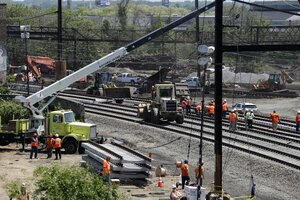Amtrak: Ways the crash might have happened – and been avoided
As investigators look for clues to the derailment of Amtrak Train 188 into Philadelphia, the Federal Railroad Administration has ordered Amtrak to take immediate steps to improve safety along the Northeast Corridor.

Workers install new track where a deadly train derailment occurred Tuesday night in Philadelphia. Amtrak is working to restore Northeast Corridor rail service between New York City and Philadelphia.
Julio Cortez/AP
As investigators gather evidence about this week’s deadly crash of Train 188 along Amtrak’s Washington-to-New York run, new reports offer some tantalizing possibilities.
One is evidence that the engine’s windshield had been damaged before the derailment, perhaps distracting or injuring engineer Brendan Bostian. As he recovers from a concussive head injury, Mr. Bostian so far remembers little of what happened in the moments surrounding the accident, which killed eight people and injured more than 200 Tuesday night.
Another are reports that Bostian’s prior run that day had been required to travel at slow speed, putting him behind schedule, reducing the time for rest and preparation, and perhaps leaving him “frazzled,” according to a longtime engineer who spoke to the Daily Beast.
Bostian’s earlier train experienced a “cab signal failure” after it departed New York for Washington Tuesday afternoon, which meant that Bostian could not rely on the electronic indicators and audible alerts in the cab and instead would have to observe, register, and interpret the signals – all of which relate to speed – with no backup.
“It’s absolutely crazy on the nerves,” the longtime engineer said.
The New York Times reports that an individual identified as Bostian had participated in a discussion group on the Trainorders.com website, where he “criticized a lack of safeguards to protect against human error, pointing out how fatigue, bad communication and ‘cutting corners’ could lead to accidents.”
“When others voiced skepticism of new safety technology, or dismissed the idea that an experienced engineer could make a simple mistake, the writer was often quick to comment to the contrary,” the newspaper reported. “The writer also said, ‘I wish the railroads had been more proactive in adopting’ safety technology.”
The route of Bostian’s last run had been equipped with the Positive Train Control System (PTC), which can automatically slow or stop a train using Wi-Fi, GPS, transponders, and other well-known technologies. But it was still being tested before becoming fully operational.
Investigators with the National Transportation Safety Board (NTSB) have described Bostian as “extremely cooperative” in the initial questioning. He voluntarily allowed a blood sample to be taken, indicating no presence of drugs, medicines, or alcohol, and he immediately turned over his cell phone, which had been switched off during the run.
At a briefing Friday, NTSB member Robert Sumwalt, who is heading the investigation, reported that one of the conductors on Train 188 heard a conversation between Bostian and the engineer on a Southeastern Pennsylvania Transportation Authority (SEPTA) train operating in the same area.
"She recalled that the SEPTA engineer had reported to the train dispatcher that he had either been hit by a rock or shot at, and the SEPTA engineer said that he had a broken windshield, and he placed his train into emergency stop," Sumwalt said. "She also believed that she heard [the Amtrak] engineer say something about his train being struck by something."
Trains being struck by thrown objects reportedly is a regular occurrence along the Northeast Corridor. The FBI is examining the windshield damage on Bostian’s train.
On Saturday, the Federal Railroad Administration (FRA) ordered Amtrak “to immediately take several actions to improve safety along its Northeast Corridor.”
This includes immediate implementation of Automatic Train Control (already in place for southbound trains) for northbound trains; analyzing the risks in all curves along the Northeast Corridor and implementing the appropriate technology “immediately”; and increasing wayside signage alerting engineers and conductors of the maximum authorized speed throughout the corridor.
“These are just initial steps, but we believe they will immediately improve safety for passengers on the Northeast Corridor,” Sarah Feinberg, the FRA’s acting administrator, said. “While full implementation of Positive Train Control is the most important step that must be taken to improve safety, it is not the only action that we will require of Amtrak and other railroads. As we learn more from the ongoing investigation of this derailment, we will take additional steps and enforcement actions as necessary.”

